
Beltane is the Gaelic May Day festival. Commonly observed on the first of May, the festival falls midway between the spring equinox and summer solstice in the northern hemisphere. The festival name is synonymous with the month marking the start of summer in Ireland, May being Mí na Bealtaine. Historically, it was widely observed throughout Ireland, Scotland, and the Isle of Man. In Irish the name for the festival day is Lá Bealtaine, in Scottish Gaelic Latha Bealltainn, and in Manx Gaelic Laa Boaltinn/Boaldyn. Beltane is one of the principal four Gaelic seasonal festivals—along with Samhain, Imbolc, and Lughnasadh—and is similar to the Welsh Calan Mai.
Imbolc or Imbolg, also called Saint Brigid's Day, is a Gaelic traditional festival. It marks the beginning of spring, and for Christians it is the feast day of Saint Brigid, Ireland's patroness saint. It is held on 1 February, which is about halfway between the winter solstice and the spring equinox. Historically, its traditions were widely observed throughout Ireland, Scotland and the Isle of Man. It is one of the four Gaelic seasonal festivals, along with: Bealtaine, Lughnasadh and Samhain.
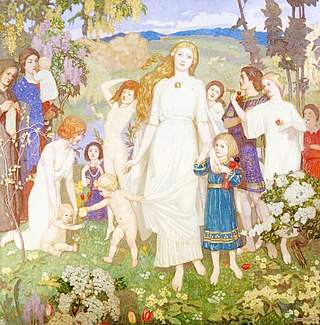
Brigid, Brigit or Bríg is a goddess of pre-Christian Ireland. She appears in Irish mythology as a member of the Tuatha Dé Danann, the daughter of the Dagda and wife of Bres, with whom she had a son named Ruadán.
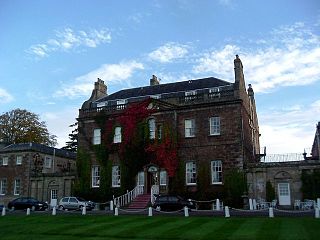
Culloden is the name of a village three miles east of Inverness, Scotland and the surrounding area. 3 mi (5 km) east of the village is Drumossie Moor, site of the Battle of Culloden.

Ancient Celtic religion, commonly known as Celtic paganism, was the religion of the ancient Celtic peoples of Europe. Because the ancient Celts did not have writing, evidence about their religion is gleaned from archaeology, Greco-Roman accounts, and literature from the early Christian period. Celtic paganism was one of a larger group of Iron Age polytheistic religions of Europe. It varied by region and over time, but underlying this were "broad structural similarities" and "a basic religious homogeneity" among the Celtic peoples.
Brehon is a term for a historical arbitration, mediative and judicial role in Gaelic culture. Brehons were part of the system of Early Irish law, which was also simply called "Brehon law". Brehons were judges, close in importance to the chiefs.

Madron is a civil parish and village in west Cornwall, Great Britain. Madron is named after Saint Madern's Church. Its annual Trafalgar Service commemorating the death of Vice Admiral Horatio Nelson was started on 27 October 1946, following a local tradition that his death was first announced on British soil in the Union Hotel, Penzance.

Sancreed is a village and civil parish in Cornwall, England, approximately three miles (5 km) west of Penzance.
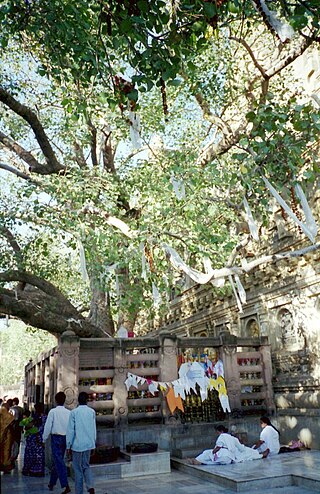
Trees are significant in many of the world's mythologies, and have been given deep and sacred meanings throughout the ages. Human beings, observing the growth and death of trees, and the annual death and revival of their foliage, have often seen them as powerful symbols of growth, death and rebirth. Evergreen trees, which largely stay green throughout these cycles, are sometimes considered symbols of the eternal, immortality or fertility. The image of the Tree of life or world tree occurs in many mythologies.
Saint Curetán was a Scoto-Pictish bishop and saint,. He is listed as one of the witnesses in the Cáin Adomnáin, where he is called "Curetan epscop". In the Martyrology of Tallaght he is called "of Ross Mand Bairend", and in the Martyrology of O'Gorman he is styled "bishop and abbot of Ross maic Bairend". His bishopric is usually held to have been Ross, the seat of which was at the settlement in the Black Isle called Ros-Maircnidh or Rosemarkie, named after the adjacent promontory

A clootie is a strip or piece of cloth, a rag or item of clothing, traditionally used to make clootie dumplings. The term clootie can also refer to fabric used in the patching of clothes or the making of clootie mats.

A wish tree is a tree, usually distinguished by species, location or appearance, which is used as an object of wishes and offerings. Such trees are identified as possessing a special religious or spiritual value. Postulants make votive offerings in hopes of having a wish granted, or a prayer answered, from a nature spirit, saint or goddess, depending on the local tradition.
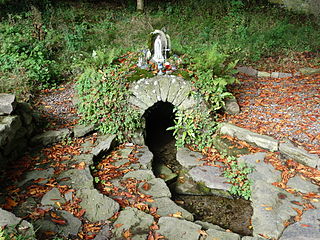
A holy well or sacred spring is a well, spring or small pool of water revered either in a Christian or pagan context, sometimes both. The water of holy wells is often thought to have healing qualities, through the numinous presence of its guardian spirit or Christian saint. They often have local legends associated with them; for example in Christian legends, the water is often said to have been made to flow by the action of a saint. Holy wells are often also places of ritual and pilgrimage, where people pray and leave votive offerings. In Celtic regions, strips of cloth are often tied to trees at holy wells, known as clootie wells.
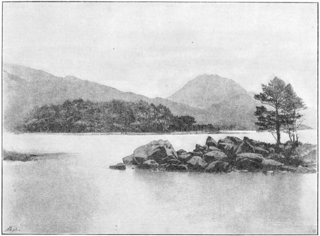
Isle Maree is an island in Loch Maree, Scotland.
According to classical sources, the ancient Celts were animists. They honoured the forces of nature, saw the world as inhabited by many spirits, and saw the Divine manifesting in aspects of the natural world.
Saint Madron or Maddern was a Pre-Congregational Saint, monk and hermit.

Madron Well and Madron Well Chapel is a scheduled Ancient Monument in the civil parish of Madron, Cornwall, UK.

Trees hold a particular role in Germanic paganism and Germanic mythology, both as individuals and in groups. The central role of trees in Germanic religion is noted in the earliest written reports about the Germanic peoples, with the Roman historian Tacitus stating that Germanic cult practices took place exclusively in groves rather than temples. Scholars consider that reverence for and rites performed at individual trees are derived from the mythological role of the world tree, Yggdrasil; onomastic and some historical evidence also connects individual deities to both groves and individual trees. After Christianisation, trees continue to play a significant role in the folk beliefs of the Germanic peoples.

The Lady's Well is a natural spring surmounted by a large cross that stands beside the Stra Burn Ford (NS254630) near Auchmannoch House in the Parish of Sorn, East Ayrshire, Scotland. It is associated with the Virgin Mary as a curative well, a Wishing Well and also a Clootie well, additionally Mary Queen of Scots is said to have once watered her horse here. A large red sandstone cross was erected here at an unrecorded date. The well is also said to have acquired its name through "..one of the ladies of Auchmannoch family drinking water exclusively from here."
St Fillan's Kirk, Seat and Well are located in the hamlet of Kilallan, once the main religious centre of the ancient parish of Kilallan or Killellan, close to Kilmacolm, Renfrewshire, Scotland. The old parish was united with Houston in 1760 although the church saw occasional use until 1771. The ruins of the kirk are a scheduled monument and the surrounding graveyard is a Listed Building. The ruins stand some 4 miles (6 km) west of the centre of Houston, just off the Kilallan Road.
















